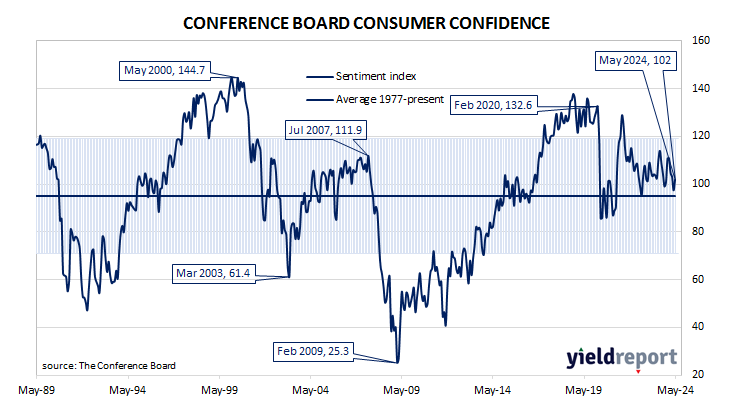Summary: Conference Board Consumer Confidence Index up in May, well above expected; Expectations Index below 80, usually signals recession ahead; US Treasury yields increase; expectations of Fed rate cuts soften; consumers cite food, groceries prices as having greatest impact on their view of US economy; views of present conditions, short-term outlook both improve.
US consumer confidence clawed its way back to neutral over the five years after the GFC in 2008/2009 and then went from strength to strength until late 2018. Measures of consumer confidence then oscillated within a relatively narrow band at historically high levels until they plunged in early 2020. Subsequent readings then fluctuated around the long-term average until March 2021 when they returned to elevated levels. However, a noticeable gap has since emerged between the two most-widely followed surveys.
The latest Conference Board survey held during the first three weeks of May indicated US consumer confidence has improved after deteriorating for the previous three months. May’s Consumer Confidence Index registered 102.0 on a preliminary basis, well above the generally-expected figure of 96.0 and April’s final figure of 97.5 after revisions.
“Despite this improvement, for the fourth consecutive month, the Expectations Index was below 80, the threshold which usually signals a recession ahead,” said Dana Peterson, Chief Economist at The Conference Board.
Short-term US Treasury bond yields rose moderately on the day while long-term yields increased more noticeably. By the close of business, the 2-year Treasury bond yield had added 3bps to 4.98%, the 10-year yield had gained 8bps to 4.55% while the 30-year finished 10bps higher at 4.67%.
In terms of US Fed policy, expectations of a lower federal funds rate in the next 12 months softened, although at least two 25bp cuts are still currently factored in. At the close of business, contracts implied the effective federal funds rate would average 5.33% in June, in line with the current spot rate, 5.33% in July and 5.265% in September. May 2025 contracts implied 4.76%, 57bps less than the current rate.
“According to May’s write-in responses, consumers cited prices, especially for food and groceries, as having the greatest impact on their view of the US economy,” Peterson added. “Notably, average 12-month inflation expectations ticked up from 5.3% to 5.4%. Perhaps as a consequence, the share of consumers expecting higher interest rates over the year ahead also rose, from 55.2% to 56.2%.”.
Consumers’ views of present conditions and their views of the near-future both improved. The Present Situation Index increased from April’s revised figure of 140.6 to 143.1 while the Expectations Index moved up from 68.8 to 74.6.
The Consumer Confidence Survey is one of two widely followed monthly US consumer sentiment surveys which produce sentiment indices. The Conference Board’s index is based on perceptions of current business and employment conditions, as well as respondents’ expectations of conditions six months in the future. The other survey, conducted by the University of Michigan, is similar and it is used to produce an Index of Consumer Sentiment. That survey differs in that it does not ask respondents explicitly about their views of the labour market and it also includes some longer-term questions.



